Manufacturer & Supplier of Induction Furnace Coil
The induction furnace coil of an induction furnace is considered its main part. The main function of the coil is to create magnetic fields required to conduct eddy currents that lead to heating or melting scrap metals or processed ores. Taking into account the role and importance of this part, the electrical and mechanical properties of the coil remarkably affect the function and efficiency of the furnace. Therefore, considering the diversity of materials and quality of parts used for manufacturing coils, Lawatherm provides a wide range of coil designs for the induction furnace, whether designed in the company or as the drawings of the original coil provided by the customers (in case a spare part is being provided). So, customers will be able to choose a design, used material, and even properties of the insulation on the intended basis.
A schematic view of conventional designs of coils manufactured by Lawatherm for its customers all across the world is as follows:
Types of Induction Furnace Coil:-
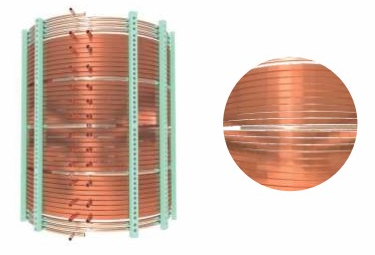
HELICAL COIL
Mostly designed using a number of contrary coils assembled to gether, Helical Coils, winded as spirals, are the most conventional ones practically. The main flaw for this design is the significant gap created between different parts of the coil including contrary active parts of the coil and neutral cooling parts. Being unable to provide smooth edges and adjust height of the coil precisely and finally im balance of magnetic field produced by the coil are the other dis advantages. Most of coils manufactured by Chinese companies and some Turkish factories are placed in this category

OFFSET COIL
The design of these coil are similar to the helical ones but with a small difference based on the idea of creating an offset in each 360-degree rotation of loops; so, each layer almost comes to a flat, horizontal condition except the offset area. Therefore the design doesn’t have the problems mentioned for the helical coils. Taking into account the physical condi-tions of coil, there is no airspace between different parts of the coil; the upper and lower parts of the coil are created as flat and parallel to enable manufacturer and user to adjust height of the coil precisely. Because of the perfect balance between loops of the coil, the magnetic field produced by coil is more harmonious in different parts inside it. Most of coils manufactured by Indian companies like Electroterm and Megatherm and also some coils made by American companies like Ajax are places in this category. It is recommended using this kind of coils in high power and high capacity furnaces.
DESIGN
The precise design of a coil, electrically and mechanically, using software and computer simulation is the first step of manufacturing a coil. This step is important not only for coils designed in the company, but also for ones manufactured on the basis of drawings provided by the costumers. Finally, according to the simulations and the results conducted, the necessary drawings and a list of required material is being executed and sent to the production department to begin the production.
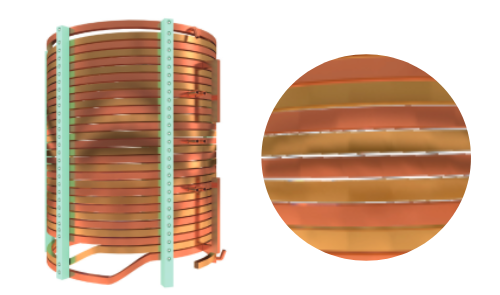
DUAL TURNS COIL
The main feature of this design is merging the two active parts of the coil together and inside each other. Generally the two active coils lo-cated at the centre are designed as spirals (like helical coils) while the upper and lower parts that are neutral cooling coils are winded as off-set coil. Advantages of this kind of coil are high functional efficiency and more suitable water circulation. Most of coils manufactured by German Companies and some Turkish companies are placed in this category.
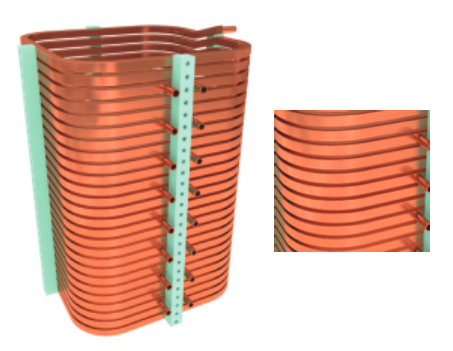
RECTANGULAR COIL
Winded in a rectangular section, a rectangular coil is mainly used in channel furnaces and sometimes in the preheating furnaces. The size of these models are generally smaller than the above-mentioned coils. This kind of coil is manufactured and used is two forms: Helical and Bended straight

ACTIVE PART
The active part of a coil is in charge of creating magnetic field required to run the melting or heating process and is composed of layers of copper tubes. There are three very important points about the copper tubes:

INDUCTION Furnace COIL METHOD 1
Lawatherm has invented a special insulator for insulating coils made by the company, named Lawa-Flex, as its brand. The most important property of this special insulator, which is an electrostatic powder dye based on epoxy, is that it doesn’t crack or separate from the coil’s surface in case of intense expansion and contraction of conductors of the coil during application. High thermal endurance, high insulation strength and uniform adhesion specification while applying with a special instrument are other properties of this special insulator. This insulator is applied TM solely, without using other auxiliary materials; no need to use other insulators like liquid ones and insulator tapes in addition to Lawa-Flex in case of using the coil in standard conditions. Taking into account that it is possible for Lawatherm to apply the said insulator, the coils manufactured may be insulated using Lawa-Flex2M as Method No.1. It should be noted that coil undergoes a complete sandblast before applying the powder insulator to remove oxide layers from its surface.

INDUCTION Furnace COIL METHOD 2
In method no.2, in addition to primary insulation of coil using Lawa-Flex, a layer insulation tape and a special epoxy liquid are used to improve security margin of application. Using this method is suggested only when the coil is used in a high risk and non-standard conditions; otherwise, in case of using the coil in a proper and standard conditions, Lawa-Flex will be sufficient.

INDUCTION Furnace COIL METHOD 3
Using this method, insulation is applied without Lawa-Flex. After a complete sandblast of the coil, its surface is coated using three layers of 1 especial epoxy dye; then, a layer of insulation tapes are winded on it and finally, a layer of special epoxy liquid varnish is sprayed on the surface. This method is used when repaired coils are insulated and miniature leakage is probable.
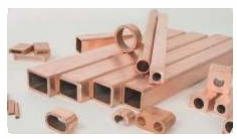
MATERIAL OF THE COPPER TUBES
The copper used to make sections applied in the active part of a coil should have the maximum purity (at least 99.9%) and con-ductivity (at least 58 mega Siemens per meter); the impure part of the material should contain the least amount of disturbing elements like Phosphorus, Oxygen and Iron that cause intense drop of conductivity, explosion and excessive heating of coil. Thus, taking into account the above-mentioned descriptions, Lawatherm uses the refined copper grade ETP-C11000 and sometimes OFC-C10100 for specific orders, to fulfil all the required conditions
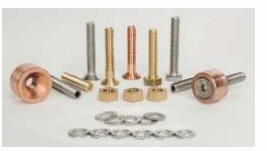
HOLDER BOLTS
Function of holders is connecting support to the body of the coil and include Stainless steel bolts grade 304 or 316, welded to the surface of copper tubes (with or without copper intermediates) or brass bolts which are restrained by flat washer, spring washer and nuts.
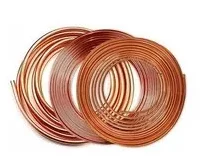
INSULATION
Coils manufactured by Lawatherm are always insulated observing all the details; all the points are insulated from each other in a multi-layer way. Since coil insulation prevents coil breakdown and continual stoppage of melting, technical experts of Lawatherm consider this matter during stages of coil manufacturing. Thus, Lawatherm suggests three methods depending on the customer’s requirement.
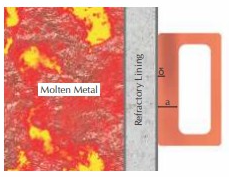
SHAPE OF SECTIONS
Amongst many properties Shape and cross section of copper tubes affects the coils productivity and long-life the most. In addition to this fact that the effective area of the section must be enough to carry the enormous current conducted through the coil, geometric shape of the section is very important and is not generally considered as it deserves. Geometric shape of the section should provide enough space for current flow of the coil considering two points: Firstly, depth of magnetic field pen-etration inside the section (which depends completely on fre-quency); secondly, quality of cooling and water flow through the conductors. Generally, blockage, sedimentation and corrosion of the copper is expected to happen at sections with sharp corners on the inside (water channel), especially if quality of coil water is not suitable. So, it is recommended using sections with curved corners while manufacturing active part of a coil, to prevent the above mentioned matter.

SLIVER BRAZING ROD & FLUX
_Lawatherm offers these alloys in a wide range of compositions to suit specific applications in the field of maintenance & repair for water pipes (cold & hot water) in copper busbar and squirrel cage rotors.
_Silver brazing produces joints that meets specifications which provides excellent flow characteristic, electrical conductivity, pressure tightness, corrosion resistance and service temperature ,metal joining operations often employ silver brazing.

COOLING PART
The main function of cooling parts of a coil is to cool down the upper and lower sections of
the coil which carry no currents. Cooling parts are generally made by pipes or rectangular
tubes made of stainless steel grade 316 or sometimes like active part of the coil, using
copper tubes

COIL SUPPORT
The main function of coil supports is to keep the gap between the layers and keeping diameter of the coil fixed during the time.
They are made of composite insulators. Specifications of an ideal support are as follows:
- High electrical resistance to ensure isolation between loops
- High tensile and flexural strength to endure electromechanical forces
- Ability to absorb minimal moisture to stabilize mechanical and electrical properties during time
- Thermal endurance in proper limitations.
The following table shows a comparison between grades used in quality of supports.


WATER-COOLED POWER LEADS
Water cooling is one of the most important factors of induction equipment; more than 90% of the problems with melt systems involve water. Most of this boils down to overheated coils, due to restricted water flow in the power leads. Lawatherm has in-house capabilities to make, rebuild or recover all makes and types, as well as to customize a cable for a specific need or application. It is highly flexible together with adequate toughness to help passing the electrical cable assembly through the hose. Copper—rated at 101% electrical conductivity by the IACS and soldered to the terminal to insure optimum contact and conductivity is used. This cable is covered with a non-conductive hose constructed of a nitrile tube, multi-ply reinforced center and a neoprene cover that protects your cable against damage from heated material, with a 1000-psi minimum burst pressure and a continuous operating pressure of 250 psi. Flange-type terminals are resurfaced and silver plated for optimum contact and electrical conductivity. These are carbon free hose offering an extremely long life through their characteristics of abrasion and weather resistance. They are specially designed and manufactured to take the abuse in the toughest of working environments. These kinds of hoses are mainly used for carrying power cables in electrical induction furnaces, servicing in iron & steel industries for protection from exposure to high temperature, current leakage and radiation from steel furnace, open flame and splashes of hot metal.

CONDUCTORS
Conductors used in Water Cooled Cables are composed of twisted copper wire strings which are mostly bare and sometimes tin plated (mostly in secondary cables). The copper used for these wire strings is completely softened (annealed) ETP grade Copper (According to ASTM C11000). Water Cooled Cables are divided into two groups regarding arrangement of conductors inside the cable: “Continuous” and “Separated”. In continuous Types, conductors of the cables are composed of thin strings in high numbers (with little number of wires); while, the separate cables are composed of conductors with wires in lower numbers which are thicker (or the number of strings is more) compared with the continuous ones. The twist angle of single strings in two adjacent layers are symmetrical.
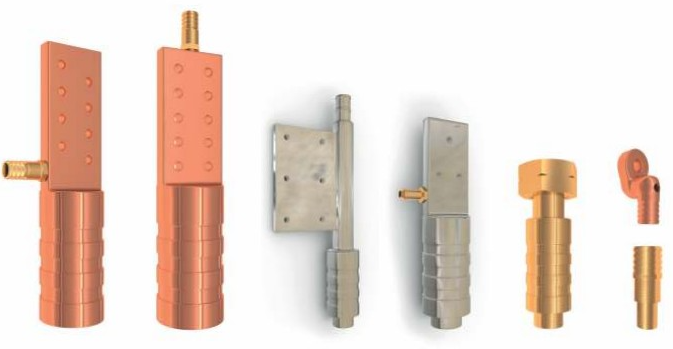
TERMINAL
Cable Heads used for manufacturing Water Cooled Cables are produced as designed in the R&D or according to the drawings provided by customers. Cable heads are generally produced as one-piece through forging and machining copper billets. Sometimes they are as multi-piece through welding machined parts which is not advised especially in high-power cables. Material of the copper used is “ETP grade copper” (according to ASTM C11000) in a softened (annealed) way. The following figure shows some of the convenient terminals (cable heads) used for manufacturing Water Cooled Cables.

WATER PASSAGE
Water Passage Canals are used by water flow to pass through the Water Cooled Cable; otherwise, water flow will b stopped because of ravels of conductors in the cable. These canals are generally used in the average-power cables and the high-power ones; using them in the low-power ones (Secondary Cables) is not necessary.
The said canals are used in two ways:
- Spring type: spring formed, made of stainless steel grade 304 or copper;
- One-piece: have a circle (tube) or polygonal cross section, made of extruded plastic, resistant to corrosion.
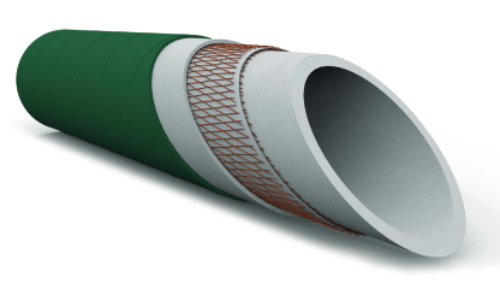
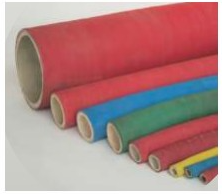
HOSE
Hoses used for Water Cooled Cables are made of carbon-free materials and are resistant to corrosion; they are strengthened by woven synthetic fibers in one or two layers to prevent from tearing. Also, the outer surface of hoses is protected using a layer of fireproof material. The maximum working pressure for Water Cooled Cables is 10 to 20 bars in case of continuous usage; the maximum tolerable pressure for them (tearing limit) is about 40 to 50 bars.
Fire-Proof Protective layer for protect hose from melted particle made by 3 Glass fibers or NBR
Reinforcement layer to prevent hose from rupture made by glass, cotton or synthetic fibers
Inner & middle layer of hose made by carbon free, anti ware, anti corrosion & electric insulator 1 2 rubber from EPDM , XLPE
- Ethylene Propylene Diene Monomer (M-Glass)
- Cross- Linked Polyethylene
- Nitrile Butadiene Rubber
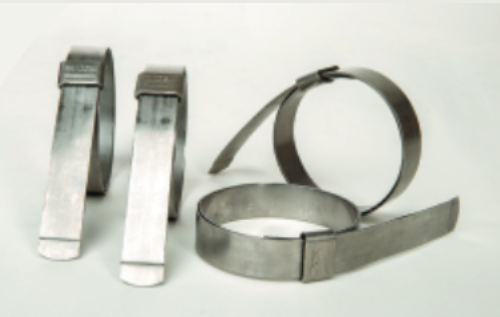
HOSE CLAMPS
The fasteners used for sealing hose of a Water-Cooled cable are made of stainless steel to prevent from heating under magnetic field around the furnace. They are used as disposable and toothless to make sure that they won’t be opened during the time

FLOW SWITCH
The Lawa make indicating type, magnetically actuated flow switches are designed for positive detection of fluid flow through your equipment. Flow range covered is from 1 to 150 LPM. Fluid Flow in the System is seen through transparent tube. The clearance between the float and inner surface of the transparent tube are large enough to let floating particles to pass through, eliminating the chances of clogging. This also reduces the pressure drop across the switch. All switches are strong and lightweight. Adequate magnetic shielding is provided as an in-built feature, enabling the user to mount the switch in any location.

PRESSURE GAUGE / PRESSURE SWITCH
Our product is very safely and efficiently designed under the supervision of our highly diligent and hardworking man force such that it is structured to facilitate ensure safe, trouble-free performance. These are known or their brilliant functioning, quality material compatibility, adequate ratings, proper installation, easy operation and maintenance. Our product range includes Vacuum Gauges, Level Gauges and Liquid Level Gauges etc. Our sole aim is to put a smile of contentment on the faces of our customers and do our best in making that possible.
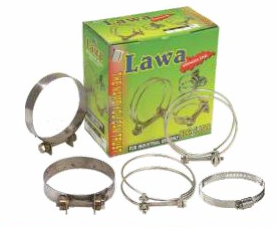
HOSE CLAMPS
The Lawa stainless Steel Hose Clamps are engineered to meet the exact requirements for our client and within the specify time frame. Our Clamps like heavy duty strip Clamps, Wire Clamps, Worm drive Clamp, have created a strong market presences due to their superior strength excellent gripping and availability in a wide range of designs
